Abstract
Cu-catalyzed reactions of N-alkoxy-2-methylanilines and alcohols in the presence of catalytic amounts of IPrCuBr and AgSbF6 afforded the corresponding meta-aminophenol derivatives in good to high yields. These reactions proceed via a [1,3]-rearrangement, in which the alkoxy group migrates from the nitrogen atom to the methyl-substituted ortho position, followed by an oxa-Michael reaction of the resulting ortho-quinol imine intermediate.
1. Introduction
meta-Aminophenol derivatives are frequently used in pharmaceutical science (Figure 1) [1,2,3,4,5]. For example, SEA0400 exhibits inhibitory activity on the Na+/Ca2+ exchanger [1], while tetrapetalone A [2] and tenaspimycin [3] inhibit lipoxygenase and Hsp90, respectively. However, performing the synthesis of meta-aminophenol scaffolds in an efficient and selective manner has been challenging because electrophilic substitution reactions, the most common approach to the functionalization of anilines and phenols, exhibit ortho/para preference. The radical hydroxylation of nitrobenzene, which occurs at the meta position, has significant drawbacks in terms of regioselectivity, reaction efficiency, and functional group compatibility (Figure 2a) [6,7,8]. The enzymatic oxidation of nitrobenzene can synthesize meta-nitrophenol with excellent site-selectivity, although this method suffers from the poor generality of substrates [9]. In this regard, transition metal-catalyzed cross-coupling reactions using meta-haloanilines and meta-halophenols are among the most frequently employed methods (Figure 2b) [10,11,12,13,14,15]. For example, Buchwald–Hartwig amination reactions of meta-halophenol derivatives using palladium catalysts [10,11,12,13] and Ullman-type reactions using copper catalysts [14,15] have been frequently used for the synthesis of meta-aminophenol derivatives. Catalytic C–O bond-forming reactions using meta-haloanilines have also been employed as an alternative approach to cross-coupling reactions by employing various transition metal catalysts, such as palladium [16,17], copper [18,19], nickel [20], and gold [21]. However, these reactions are also inherently associated with the selectivity issue in meta-haloaniline/phenol preparations. Although other approaches to functionalized meta-aminophenol derivatives have been recently reported [22], the development of efficient and robust methods for the synthesis of multiply substituted meta-aminophenol derivatives is a pressing issue.
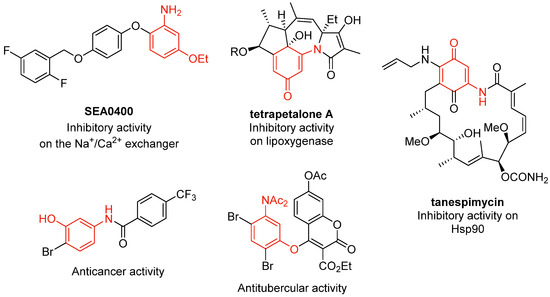
Figure 1.
meta-aminophenol derivatives.

Figure 2.
Conventional methods for the synthesis of meta-aminophenol derivatives.
Against this backdrop, we designed cascade reactions, including the Cu-catalyzed [1,3]-rearrangement, as a potential approach to overcome issues related to selectivity (Figure 3) [23,24,25,26,27,28,29,30,31,32]. We have recently reported that N-heterocyclic carbene (NHC)-ligated cationic copper catalysts efficiently promote the [1,3]-rearrangement of N-alkoxyanilines [23,24,25,26,27]. Specifically, N-alkoxyanilines 1 having an electron-donating group (EDG) at the ortho position selectively generated functionalized ortho-quinol imine intermediates A via a [1,3]-rearrangement of the alkoxy group to the EDG-substituted ortho position [25,26,27,28]. ortho-quinol imine intermediates A underwent favorable transformations, including a [1,2]-rearrangement (Figure 3a) [25]; a Michael addition with carbon nucleophiles such as N-methylindole, 1,3,5-trimethoxybenzene, and dimethyl malonate (Figure 3b) [26]; and a Diels–Alder reaction with electron-rich and electron-deficient olefins [27]. It should be emphasized that the Cu-catalyzed [1,3]-rearrangement can generate functionalized quinol imine intermediates A, which had been inaccessible via conventional methods, such as thermally induced rearrangement [33] and oxidation [34]. Accordingly, we envisioned that the reactions with alcohols as oxygen nucleophiles would give functionalized meta-aminophenol derivatives in a selective manner through an oxa-Michael addition of generated ortho-quinol imine intermediates A (Figure 3d) [35,36]. Here, we report the Cu-catalyzed [1,3]-rearrangement—oxa-Michael addition—aromatization cascade reactions of N-alkoxyanilines 1 and alcohol nucleophiles 2, which afforded meta-aminophenol derivatives 3 in good-to-acceptable yields (Figure 4).
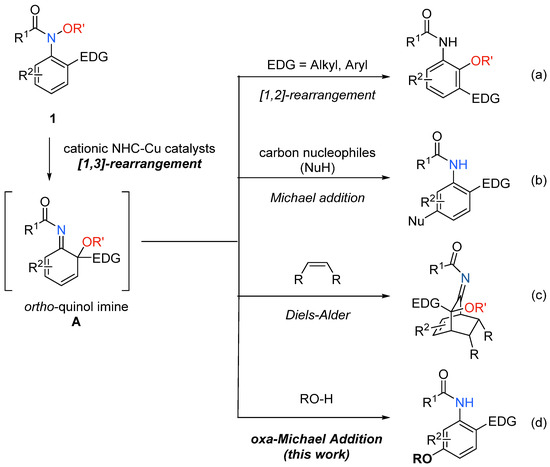
Figure 3.
Cu-catalyzed [1,3]-alkoxy rearrangement: (a) domino [1,3]/[1,2] rearrangement, (b) [1,3]-rearrangement—Michael addition, (c) [1,3]-rearrangement—Diels-Alder reaction, and (d) [1,3]-rearrangement—oxa-Michael addition (this work).

Figure 4.
Cu-catalyzed [1,3]-rearrangement—oxa-Michael addition cascade reaction.
2. Results and Discussion
Initially, the reaction of N-methoxy-2-methylaniline 1a having a p-trifluoromethylbenzoyl group on the nitrogen atom and one equivalent of methanol 2a in the presence of catalytic amounts of IPrCuBr [IPr: N,N′-bis(2,6-diisopropylphenyl)-imidazol-2-ylidene, 10 mol%] and AgSbF6 (10 mol%) in chlorobenzene at 70 °C afforded a mixture of the following four regioisomers: desired 6-methyl-3-anisidine 3aa; 2-methyl-3-anisidine 4aa, which was derived from the oxa-Michael addition to the meta position next to the ortho-methyl group; 3-methyl-2-anisidine 5a, which was derived from domino [1,3]/[1,2]-rearrangement reactions [25]; and 6-methyl-2-anisidine 6a, which was derived from the [1,3]-rearrangement reactions of the methoxy group to the unsubstituted ortho position (namely, [1,3]′-rearrangement) to generate ortho-quinol imine intermediate 7a′ (Scheme 1). Attempts to optimize the reaction conditions to selectively synthesize 3aa were unsuccessful.
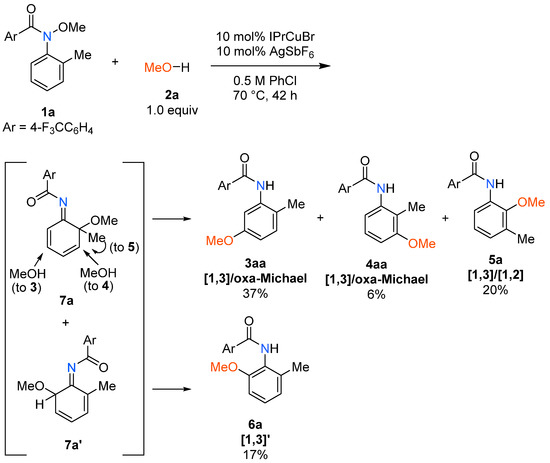
Scheme 1.
Cu-catalyzed reaction of 1a and methanol 2a.
To reduce the number of regioisomers prior to the optimization of reaction conditions, we preliminary screened several starting materials 1. To our delight, the reaction of substrate 1b having a fluorine atom at the para position of the aniline ring at 70 °C generated two regioisomers, 3ba and 6b. Among the NHC ligands examined, IPr exhibited the best reactivity and product selectivity (Table 1, entry 1), whereas the use of IMes [1,3-Bis(2,4,6-trimethylphenyl)-1,3-dihydro-2H-imidazol-2-ylidene] and SIPr [1,3-bis(2,6-diisopropylphenyl)imidazolidine] resulted in low catalytic activity (entries 2 and 3). The reactivity was significantly affected by counteranions; less coordinative counteranions such as hexafluoroantimonate were effective for the present transformations. On the other hand, when AgBF4 and AgNTf2 were used instead of AgSbF6, 3ba was formed in low chemical yields along with a considerable amount of recovered 1b (entries 4 and 5). The reaction in 1,2-dichloroethane (DCE) proceeded quickly to afford product 3ba in the best yield among the solvents examined (entries 6–9). Neither the chemical yield nor the product selectivity was improved when the temperature of the reaction of 1b and 2a was changed from 70 °C to 60 °C and 80 °C, respectively (entries 10 and 11). The reaction in the absence of either Cu or Ag did not yield desired product 3ba; N-methoxyaniline 1b was quantitatively recovered (entries 12 and 13).

Table 1.
Optimization of reaction conditions.
The protecting group on the nitrogen atom significantly affected the product selectivity (Table 2, entries 1–4); desired meta-anisidines 3 were obtained with better product selectivity with carbamate-type protecting groups (entries 2–4) than with the amide-type protecting groups (Table 1 entry 6, and Table 2, entry 1). The use of one equivalent of methanol 2a was effective, whereas the use of a large excess (five equivalents) of methanol 2a diminished the catalytic activity (entry 2 versus entry 6). It should be noted that the reaction using half an equivalent of methanol at 80 °C afforded 3da in the 71% yield, suggesting that the methoxy group eliminated from substrate 1d participated in the reaction as a nucleophile (entry 8). Finally, the chemical yield was improved by increasing the scale from 0.2 mmol to 0.5 mmol (entry 9, Appendix A).

Table 2.
Optimization of the protecting group of 1 and the molar amount of methanol 2a.
The optimized conditions (Table 2, entry 9) were applied to the reactions of various N-methoxyanilines 1, as summarized in Table 3. The reactions of substrates 1g and 1h, having a methyl and a phenyl group, respectively, at the para position, proceeded at 70 °C, affording corresponding meta-anisidines 3ga and 3ha in good yields (entries 1 and 2). Substrate 1j, having a bromo group, was converted into desired product 3ja when the loading amount of the Cu catalyst was increased (20 mol%, entry 7). The chemical yield of 3ia, which has a chloro group at the para position, was slightly improved when the reaction was performed at 90 °C using chlorobenzene instead of DCE as the solvent (entries 3–5). An iodo group (1k) was tolerated under the present reaction conditions, affording multi-substituted meta-aminophenol derivative 3ka in an acceptable yield (entry 8). 3-Anisidine 3la, which has an alkynyl group at the para position of the nitrogen atom, could also be generated (entry 9). In contrast, substrate 1m having a methoxycarbonyl group at the para position, exclusively afforded domino-rearrangement byproduct 5m (entry 10). The reaction of N-ethoxyaniline 1n and ethanol 2b afforded corresponding 3-ethoxyaniline 3nb in a good yield (Scheme 2).

Table 3.
Cu-catalyzed reactions of N-methoxyanilines 1g-m and methanol 2a a.

Scheme 2.
Cu-catalyzed reaction of N-ethoxyaniline 1n and ethanol 2b.
The reaction of N-methoxyaniline 1d and one equivalent of 2-phenethyl alcohol 2c afforded 3-phenylethoxyaniline 3dc in a 51% yield, along with 3da, which was produced through the oxa-Michael addition of methanol derived from 1d, in a 14% yield (Table 4, entry 1). The use of two equivalents of 2c did not improve the product selectivity (entry 2). The reaction of 1d and allyl alcohol 2d also afforded 3-allyloxyaniline 3dd as the major product (entry 3). These results suggest that substrates 1 react more preferentially with external alcohols 2c and 2d than with methanol 2a derived from 1, although the product selectivity depends on the structure of 2. When tert-butanol (2e) and phenol (2f) were employed as an alcohol nucleophile, the reactions gave a mixture of unidentified products (entries 4 and 5).

Table 4.
Cu-catalyzed reactions of N-methoxyanilines 1d and alcohols 2.
A proposed mechanism for the Cu-catalyzed reactions of N-methoxyanilines 1 and alcohol nucleophiles 2 is illustrated in Figure 5a. The cationic copper catalyst coordinates to 1 to form chelate complex 8, and this is followed by an oxidative addition of the N–O bond to the Cu(I) catalyst to form Cu(III) complex 9 [29]. Because of the contribution of canonical form 9′, a C–O bond is formed at the methyl-substituted ortho position, generating ortho-quinol imine intermediates 10 that coordinate to the cationic Cu catalyst. Electrophilically activated ortho-quinol imine intermediates 10 undergo nucleophilic addition of 2 to form Cu enamide species 11. Finally, proton transfer and elimination of methanol 2a give products 3 along with the regenerated cationic Cu catalyst. Byproducts 5 are formed via a Cu-catalyzed [1,2]-rearrangement of ortho-quinol imine intermediates 12 [25]. The product selectivity of the present reaction system was greatly influenced by the para substituent; a fluorine atom (1d) was effective in suppressing the formation of the domino [1,3]/[1,2]-rearrangement product (5, Table 2, entry 9). This is possibly because the mesomeric electron-donating effect of the fluorine atom increases the electron density of the carbon next to the quaternary carbon in ortho-quinol imine intermediates 10d/10d′, decelerating the [1,2]-rearrangement of the methyl group (Figure 5(bi)). In contrast, when an ester group was present, the selective formation of the domino rearrangement product (5m) occurred even in the presence of methanol (Table 3, entry 10), presumably because of the undesired [1,2]-rearrangement reaction facilitated by the electron-withdrawing effect (Figure 5(bii)). In addition, because substrate 1m reacted with stronger carbon nucleophiles, such as 1,3,5-trimethoxybenzene, via [1,3]-rearrangement/Michael addition [26], the low nucleophilicity of alcohols 2 also causes the selective formation of byproduct 5m. Our preliminary DFT calculations for the [1,2]-rearrangement of para-substituted ortho-quinol imine intermediates 10 were in good agreement with these experimental results (Figure 5c). The reaction of N-methoxyaniline 1d and alcohol 2c afforded 3dc (51%) in a higher yield than 3da (14%) derived from the reaction of 1d and generated methanol 2a (Table 4, entry 1). Because the product selectivity is dependent on the structure of external alcohols 2c and 2d, the elimination of methanol 2a from enamide intermediates 11 may be mediated by external alcohol 2, affecting the concentration of methanol 2a. Further investigations to understand the reactivity of key intermediates 10 are under way in our laboratory.
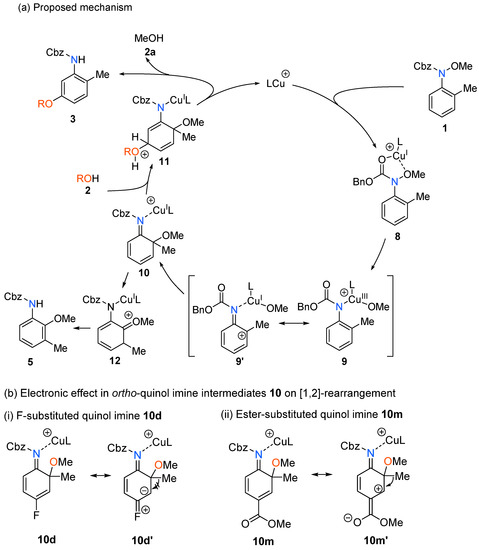
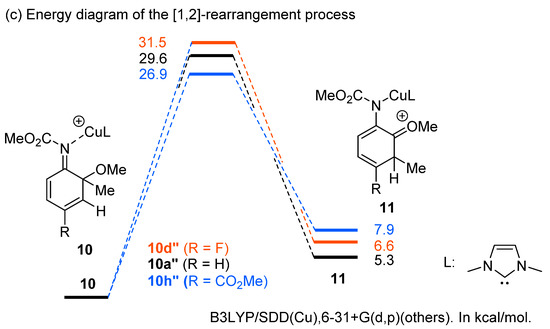
Figure 5.
Mechanistic studies.
3. Materials and Methods
The general procedure for the Cu-catalyzed reactions of N-methoxyaniline 1d and methanol 2a is as follows: DCE (1.0 mL) and methanol 2a (20.3 μL, 0.5 mmol) were added to a mixture of IPrCuBr (26.6 mg, 0.05 mmol), AgSbF6 (24.0 mg, 0.05 mmol), and 1d (144.8 mg, 0.5 mmol) under an argon atmosphere, and the mixture was stirred at 70 °C for 48 h. After complete consumption of 1d, as monitored via TLC, the mixture was passed through a pad of silica gel with ethyl acetate (50 mL). The solvents were removed in vacuo, and the crude product was purified via silica gel column chromatography using hexane/ethyl acetate (20/1) as an eluent to afford 3da (123.3 mg, 0.426 mmol, 85% yield) in an analytically pure form (Supplementary Materials).
4. Conclusions
In conclusion, we have developed a new approach to prepare meta-aminophenol derivatives via Cu-catalyzed cascade reactions involving [1,3]-rearrangement, oxa-Michael addition, and aromatization in an efficient manner. Because a variety of functional groups are tolerated in this transformation, the present method is potentially useful for synthesizing a new class of meta-aminophenol derivatives.
Supplementary Materials
The following supporting information can be downloaded at: https://www.mdpi.com/article/10.3390/molecules28104251/s1, SI (pdf). All experimental data, detailed experimental procedures, and 1H NMR, 13C NMR, 19F NMR spectral are available online.
Author Contributions
Conceptualization, I.N.; investigation, M.T. (Mai Tachibana), R.K. and H.T.; writing—original draft preparation, I.N.; writing—review and editing, I.N. and M.T. (Masahiro Terada); visualization, I.N.; supervision, M.T. (Masahiro Terada); project administration, I.N.; funding acquisition, M.T. (Masahiro Terada) and I.N. All authors have read and agreed to the published version of the manuscript.
Funding
This work was supported by JSPS KAKENHI Grant Number JP17H06447, a Grant-in-Aid for Scientific Research on Innovative Areas “Hybrid Catalysis for Enabling Molecular Synthesis on Demand” and JP20H02731, Grant-in-Aid for Scientific Research (B) from MEXT, Japan.
Institutional Review Board Statement
Not applicable.
Informed Consent Statement
Not applicable.
Data Availability Statement
The data presented in this study are available in this article.
Acknowledgments
The computation was performed using Research Center for Computational Science, Okazaki, Japan (Project: 22-IMS-C127, 21-IMS-C205).
Conflicts of Interest
The authors declare no conflict of interest.
Sample Availability
Samples of the compounds 3aa-ma, 3dc, and 3dd are available from the authors.
Appendix A
It is assumed that the larger reaction scale reduces influence of trace water on the reaction system, which can cause deactivation of the Cu catalysts and byproduct formation.
References
- Matsuda, T.; Arakawa, N.; Takuma, K.; Kishida, Y.; Kawasaki, Y.; Sakaue, M.; Takahashi, K.; Takahashi, T.; Suzuki, T.; Ota, T.; et al. SEA0400, a Novel and Selective Inhibitor of the Na+-Ca2+ Exchanger, Attenuates Reperfusion Injury in the In Vitro and In Vivo Cerebral Ischemic Models. J. Pharmacol. Exp. Ther. 2001, 298, 249–256. [Google Scholar] [PubMed]
- Komoda, T.; Sugiyama, Y.; Abe, N.; Imachi, M.; Hirota, H.; Hirota, A. Tetrapetalone A, a novel lipoxygenase inhibitor from Streptomyces sp. Tetrahedron Lett. 2003, 44, 1659–1661. [Google Scholar] [CrossRef]
- Kamal, A.; Thao, L.; Sensintaffar, J.; Zhang, L.; Boehm, M.F.; Fritz, L.C.; Burrows, F.J. A high-affinity conformation of Hsp90 confers tumour selectivity on Hsp90 inhibitors. Nature 2003, 425, 407–410. [Google Scholar] [CrossRef]
- Liang, J.; Tang, Y.-X.; Tang, X.-Z.; Liang, H.-J.; Gao, Y.; Fang, C.; Zhang, T.-Y.; Yan, M. Discovery of meta-Amido Bromophenols as New Antitubercular Agents. Chem. Pharm. Bull. 2019, 67, 372–381. [Google Scholar] [CrossRef]
- Radwan, E.M.; Elsayed, E.H.; El-Moneim, M.A.; Moustafa, A.M.Y. Synthesis and Cytotoxicity against Human Breast Carcinoma Cell Evaluation of Some New 3,4-Disubstituted Coumarin Derivatives. Pharm. Chem. J. 2022, 55, 1040–1049. [Google Scholar] [CrossRef]
- Marusawa, H.; Ichikawa, K.; Narita, N.; Murakami, H.; Ito, K.; Tezuka, T. Hydroxyl Radical as a Strong Electrophilic Species. Bioorg. Med. Chem. 2002, 10, 2283–2290. [Google Scholar] [CrossRef]
- Bianchi, D.; Bertoli, M.; Tassinari, R.; Ricchi, M.; Vignola, R. Direct synthesis of phenols by iron-catalyzed biphasic oxidation of aromatic hydrocarbons with hydrogen peroxide. J. Mol. Catal. A Chem. 2003, 200, 111–116. [Google Scholar] [CrossRef]
- Palmisano, G.; Addamo, M.; Augugliaro, V.; Caronna, T.; García-López, E.; Loddo, V.; Palmisano, L. Influence of the substituent on selective photocatalytic oxidation of aromatic compounds in aqueous TiO2 suspensions. Chem. Commun. 2006, 1012–1014. [Google Scholar] [CrossRef]
- Fishman, A.; Tao, Y.; Rui, L.; Wood, T.K. Controlling the Regiospecific Oxidation of Aromatics via Active Site Engineering of Toluene para-Monooxygenase of Ralstonia pickettii PKO1. J. Biol. Chem. 2005, 280, 506–514. [Google Scholar] [CrossRef]
- Michael, S.; Driver, M.S.; Hartwig, J.F. A Second-Generation Catalyst for Aryl Halide Amination: Mixed Secondary Amines from Aryl Halides and Primary Amines Catalyzed by (DPPF)PdCl2. J. Am. Chem. Soc. 1996, 118, 7217–7218. [Google Scholar]
- Wagaw, S.; Yang, B.H.; Buchwald, S.L. A Palladium-Catalyzed Strategy for the Preparation of Indoles: A Novel Entry into the Fischer Indole Synthesis. J. Am. Chem. Soc. 1998, 120, 6621–6622. [Google Scholar] [CrossRef]
- Browning, R.G.; Mahmud, H.; Badarinarayana, V.; Lovely, C.J. Synthesis of chiral N-aryl pyrrolidinones via a palladium-catalyzed cross-coupling reaction. Tetrahedron Lett. 2001, 42, 7155–7157. [Google Scholar] [CrossRef]
- Kim, B.R.; Cho, S.-D.; Kim, E.J.; Lee, I.-H.; Sung, G.H.; Kim, J.-J.; Lee, S.-G.; Yoon, Y.-J. Efficient palladium-catalyzed amination of aryl chlorides using di(dicyclohexylamino)phenylphosphine as a PN2 ligand. Tetrahedron 2012, 68, 287–293. [Google Scholar] [CrossRef]
- Ma, D.; Zhang, Y.; Yao, J.; Wu, S.; Tao, F. Accelerating Effect Induced by the Structure of α-Amino Acid in the Copper-Catalyzed Coupling Reaction of Aryl Halides with α-Amino Acids. Synthesis of Benzolactam-V8. J. Am. Chem. Soc. 1998, 120, 12459–12467. [Google Scholar] [CrossRef]
- Wolter, M.; Klapars, A.; Buchwald, S.L. Synthesis of N-Aryl Hydrazides by Copper-Catalyzed Coupling of Hydrazides with Aryl Iodides. Org. Lett. 2001, 3, 3803–3805. [Google Scholar] [CrossRef]
- Torraca, K.E.; Huang, X.; Parrish, C.A.; Buchwald, S.L. An Efficient Intermolecular Palladium-Catalyzed Synthesis of Aryl Ethers. J. Am. Chem. Soc. 2001, 123, 10770–10771. [Google Scholar] [CrossRef]
- Cheung, C.W.; Stephen, L.; Buchwald, S.L. Mild and General Palladium-Catalyzed Synthesis of Methyl Aryl Ethers Enabled by the Use of a Palladacycle Precatalyst. Org. Lett. 2013, 15, 3998–4001. [Google Scholar] [CrossRef]
- Wolter, M.; Nordmann, G.; Job, G.E.; Buchwald, S.L. Copper-Catalyzed Coupling of Aryl Iodides with Aliphatic Alcohols. Org. Lett. 2002, 4, 973–976. [Google Scholar] [CrossRef]
- Tlili, A.; Xia, N.; Monnier, F.; Taillefer, M. A Very Simple Copper-Catalyzed Synthesis of Phenols Employing Hydroxide Salts. Angew. Chem. Int. Ed. 2009, 48, 8725–8728. [Google Scholar] [CrossRef]
- Yang, L.; Yan, Y.; Cao, N.; Hao, J.; Li, G.; Zhang, W.; Cao, R.; Wang, C.; Xiao, J.; Xue, D. Ni(I)-Catalyzed Hydroxylation of Aryl Halides with Water under Thermal Catalysis. Org. Lett. 2022, 24, 9431–9435. [Google Scholar] [CrossRef]
- Das, A.; Nitin, T.; Patil, N.T. Ligand-Enabled Gold-Catalyzed C(sp2)–O Cross-Coupling Reactions. ACS Catal. 2023, 13, 3847–3853. [Google Scholar] [CrossRef]
- Weaver, M.G.; Bai, W.-J.K.; Jackson, S.K.; Pettus, T.R.R. Diels–Alder Construction of Regiodifferentiated meta-Amino Phenols and Derivatives. Org. Lett. 2014, 16, 1294–1297. [Google Scholar] [CrossRef] [PubMed]
- Nakamura, I.; Jo, T.; Ishida, Y.; Tashiro, H.; Terada, M. Cationic N-Heterocyclic Carbene Copper-Catalyzed [1,3]-Alkoxy Rearrangement of N-Alkoxyanilines. Org. Lett. 2017, 19, 3059–3062. [Google Scholar] [CrossRef] [PubMed]
- Nakamura, I.; Nozawa, S.; Ishida, Y.; Muranushi, I.; Mayerweg, A.; Terada, M. Copper-catalyzed [1,3]-alkoxy rearrangement for the selective synthesis of polycyclic ortho-aminoarenol derivatives. Org. Chem. Front. 2021, 8, 6390–6394. [Google Scholar] [CrossRef]
- Ishida, Y.; Nakamura, I.; Terada, M. Copper-catalyzed Domino [1,3]/[1,2] Rearrangement for the Efficient Synthesis of Multisubstituted ortho-Anisidines. J. Am. Chem. Soc. 2018, 140, 8629–8633. [Google Scholar] [CrossRef]
- Nakamura, I.; Tashiro, H.; Ishida, Y.; Terada, M. Synthesis of meta-Substituted Anilines via Copper-Catalyzed [1,3]-Methoxy Rearrangement. Org. Lett. 2020, 22, 3794–3798. [Google Scholar] [CrossRef]
- Nakamura, I.; Masukawa, K.; Ishida, Y.; Terada, M. Cu-Catalyzed [1,3]-Alkoxy Rearrangement/Diels–Alder Cascade Reactions via in Situ Generation of Functionalized ortho-Quinol Imines. Org. Lett. 2021, 23, 4127–4132. [Google Scholar] [CrossRef]
- Fang, Y.-Q.; Dang, L. Mechanistic Study of Domino Rearrangement-Promoted Meta C–H Activation in 2-Methyl-N-methoxyaniline via Cu(NHC)+: Motivation and Selectivity. Org. Lett. 2020, 22, 9178–9183. [Google Scholar] [CrossRef]
- Suzuki, M.; Terada, M.; Nakamura, I. Copper-Catalyzed [1,3]-Nitrogen Rearrangement of O-Aryl Ketoximes via Oxidative Addition of N-O Bond in Inverse Electron Flow. Chem. Sci. 2023; accepted manuscript. [Google Scholar] [CrossRef]
- Zhou, S.; Li, Y.; Liu, X.; Hu, W.; Ke, Z.; Xu, X. Enantioselective Oxidative Multi-Functionalization of Terminal Alkynes with Nitrones and Alcohols for Expeditious Assembly of Chiral α-Alkoxy-β-amino-ketones. J. Am. Chem. Soc. 2021, 143, 14703–14711. [Google Scholar] [CrossRef]
- Liu, X.; Tian, X.; Huang, J.; Qian, Y.; Xu, X.; Kang, Z.; Hu, W. Enantioselective Propargylation of Oxonium Ylide with α-Propargylic-3-Indolymethanol: Access to Chiral Propargylic Indoles. Org. Lett. 2022, 24, 1027–1032. [Google Scholar] [CrossRef]
- Yang, X.; Hong, K.; Zhang, S.; Zhang, Z.; Zhou, S.; Huang, J.; Xu, X.; Hu, W. Asymmetric Three-Component Reaction of Two Diazo Compounds and Hyrdroxylamine Derivatives for the Access to Chiral α-Alkoxy-β-amino-carboxylates. ACS Catal. 2022, 12, 12302–12309. [Google Scholar] [CrossRef]
- Fishbein, J.C.; McClelland, R.A. Cyclohexadienes from the rearrangement of O-aroyl-N-acetyl-N-(2,6-dimethylphenyl)hydroxylamines. Reaction in aqueous solution to meta- and para-substituted 2,6-dimethylacetanilides. J. Chem. Soc. Perkin Trans. 2 1995, 653–662. [Google Scholar] [CrossRef]
- Quideau, S.; Pouységu, L.; Ozanne, A.; Gagnepain, J. Oxidative Dearomatization of Phenols and Anilines via λ3- and λ5-Iodane-Mediated Phenylation and Oxygenation. Molecules 2005, 10, 201–216. [Google Scholar] [CrossRef] [PubMed]
- Hu, J.; Bian, M.; Ding, H. Recent application of oxa-Michael reaction in complex natural product synthesis. Tetrahedron Lett. 2016, 57, 5519–5539. [Google Scholar] [CrossRef]
- Nising, C.F.; Bräse, S. Recent developments in the field of oxa-Michael reactions. Chem. Soc. Rev. 2012, 41, 988–999. [Google Scholar] [CrossRef]
Disclaimer/Publisher’s Note: The statements, opinions and data contained in all publications are solely those of the individual author(s) and contributor(s) and not of MDPI and/or the editor(s). MDPI and/or the editor(s) disclaim responsibility for any injury to people or property resulting from any ideas, methods, instructions or products referred to in the content. |
© 2023 by the authors. Licensee MDPI, Basel, Switzerland. This article is an open access article distributed under the terms and conditions of the Creative Commons Attribution (CC BY) license (https://creativecommons.org/licenses/by/4.0/).



